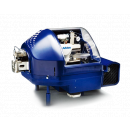应用领域:
资料类型:
Journal of Molecular Biology, Volume 369, Issue 2, 1 June 2007, Pages 541–552 A Simple, RNA-Mediated Allosteric Switch Controls the Pathway to Formation of a T =3 Viral Capsid 【Abstract】 Using mass spectrometry we have detected both assembly intermediates and the final product, the T = 3 viral capsid, during reassembly of the RNA bacteriophage MS2. Assembly is only efficient when both types of quasiequivalent coat protein dimer seen in the final capsid are present in solution. NMR experiments confirm that interconversion of these conformers is allosterically regulated by sequence-specific binding of a short RNA stem–loop. Isotope pulse–chase experiments confirm that all intermediates observed are competent for further coat protein addition, i.e., they are all on the pathway to capsid formation, and that the unit of capsid growth is a coat protein dimer. The major intermediate species are dominated by stoichiometries derived from formation of the particle threefold axis, implying that there is a defined pathway toward the T = 3 shell. These results provide the first experimental evidence for a detailed mechanistic explanation of the regulation of quasiequivalent capsid assembly. They suggest a direct role for the encapsidated RNA in assembly in vivo, which is consistent with the structure of the genomic RNA within wild-type phage. 【Abbreviations used】 CP, coat protein; ESI-MS, electrospray ionization-mass spectrometry 【Keywords】 virus assembly; RNA–protein interaction; mass spectrometry Samples were analyzed by positive ionization nanoelectrospray using an LCT Premier Mass Spectrometer (Waters Corp., Manchester, UK) with collisional cooling capabilities equipped with a NanoMate (Advion, Inc.,Ithaca, NY, USA) temperature-controlled automated sample handling and ionization interface.




